The Iditarod Historic Trail Alliance (IHTA) provided the following highlights for the Iditarod NHT during the 2021 calendar year:
Local Economy, Tourism and Community Health
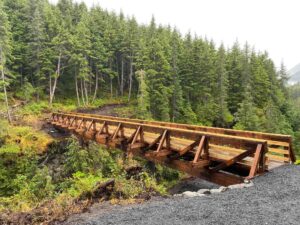
New bridge constructed over Falls Creek in Chugach National Forest, connecting segments of the Iditarod National Historic Trail. Photo by Chugach National Forest staff, 2021.
The Forest Service manages the Southern Trek of the Iditarod National Historic Trail. In the summer of 2021, the Chugach National Forest completed several construction and maintenance projects with the help of the Alaska Trail Stewards who hosted volunteer events for maintenance work in both the Girdwood Ranger District and Seward Ranger District.
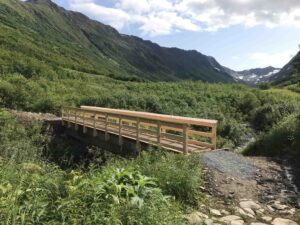
Newly constructed bridge in Turnagain Pass, Chugach National Forest, Iditarod National Historic Trail. Photo by Chugach National Forest staff, 2021.
Collaboration and Engagement
The Iditarod Historic Trail Alliance is partnering with the White Mountain Native Corporation (WMNC), a Alaska Native Claims Settlement Act village corporation, to build a new shelter cabin to replace the existing nearby shelter cabin that was severely damaged by flooding and glaciation.
The new 12’x16’ shelter cabin would be on the Iditarod Trail in an area near the “A Frame” cabin located between the Topkok Shelter Cabin and White Mountain but on high, dry ground. The general area is known for poor trail conditions, hazardous creek and river crossings, overflow, high winds, and white-out blizzard conditions. Also, high traffic on the trail is during the time of year when temperatures are usually below freezing.
The new shelter cabin will provide an emergency shelter for mushers and other trail users along the long stretch of trail. WMNC worked with the White Mountain Volunteer Fire Department (WMVFD)/Search & Rescue team to identify the best location for the cabin in the area during the summer of 2021. WMNC will work with volunteers and the WMVFD/Search & Rescue team to construct the cabin. Timing of the construction of the cabin is dependent on COVID-19 considerations and may take place in the summer of 2022. Because of the remoteness of the site, helicopters will be used to transport materials and volunteers to the construction site.
Following construction, WMNC will take responsibility for periodic maintenance and repairs to the cabin and will ensure that the cabin is stocked with firewood.
Education, Interpretation and Community Health
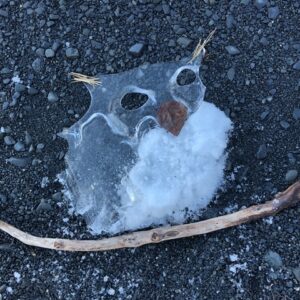
The result of an outdoor art session at an iTREC! workshop. Courtesy IHTA.
Spring of 2021 marked the successful completion of the eleven years of the Iditarod Trail to Every Classroom program (iTREC!). iTREC! is a yearlong professional development program that provides teachers with place-based, service-learning skills to help today’s youth become lifelong stewards of Alaska’s public lands, natural resources, and cultural heritage. Within the eleven years of this long-running, successful partnership, over 130 teachers have completed the program and are now engaging over 10,000 students in thirteen different subject areas in eleven communities along the Iditarod National Historic Trail. The Covid-19 pandemic required a shift in how the program is delivered – replacing face-to-face meetings with virtual workshops and a series of online webinars. In the fall of 2021 the partnership launched the beginning of its twelfth iTREC! program for the 2021-2022 school year.
iTREC! is a collaborative effort between the Iditarod Historic Trail Alliance, Forest Service, Bureau of Land Management, and the Anchorage Park Foundation. Teachers completing the webinar series can sign up for university credit with the University of Alaska Anchorage. The instructor of record, environmental education instructor Delia Clark, has been with iTREC! from the beginning.
Other Highlights
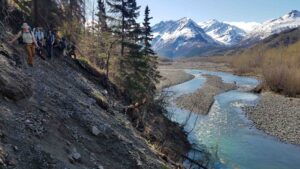
Student Conservation Association and Chugach State Park trail crew on Crow Pass segment of Iditarod National Historic Trail, Chugach State Park. Photo by Clayton Rudiger.
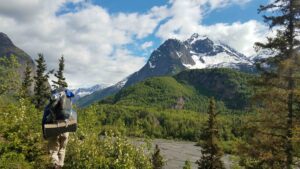
Crow Pass Trail Ambassador Karl Boehmer at “the Perch” on the Crow Pass segment of the Iditarod National Historic Trail, Chugach State Park. Photo by Clayton Rudiger.
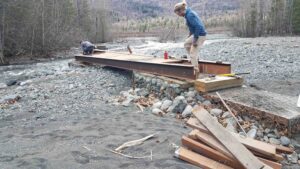
Crow Pass Trail Ambassador Karl Boehmer assists Chugach State Park trail crew on bridge repairs on the Crow Pass segment of the Iditarod National Historic Trail, Chugach State Park. Photo by Clayton Rudiger.